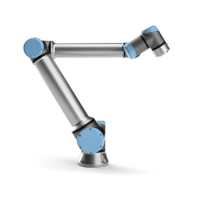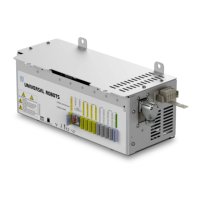Trigger Reaction
Safeguard Stop Stop Category 2.
Limit Violation Stop Category 0.
Fault Detection Stop Category 0.
NOTE
If the safety system detects any fault or violation, all safety outputs re-set to low.
2.5. Modes
Normal and Reduced Mode
The safety system has two configurable Modes: Normal and Reduced. Safety limits can be
configured for each of these two modes. Reduced Mode is active when the robot tool/end effector
is positioned on the Reduced Mode side of a Trigger Reduced Mode plane or when triggered by a
safety input.
Using a plane to trigger Reduced Mode: When the robot moves from the Reduced Mode side of
the trigger plane, back to the Normal Mode side, there is a 20mm area around the trigger plane
where both Normal and Reduced Mode limits are allowed. It prevents the Safety Mode from
flickering if the robot is right at the limit.
Using an input to trigger Reduced Mode: When an input is used (to either start or stop Reduced
Mode), up to 500ms can elapse before the new mode limit values are applied. This could happen
either when changing Reduced Mode to Normal Mode OR changing Normal Mode to Reduced
Mode. It allows the robot to adapt e.g. the speed to the new safety limits.
Recovery Mode
When a safety limit is exceeded, the safety system must be restarted. If the system is outside a
safety limit at start-up (e.g.outside a joint position limit), the special Recovery Mode is entered. In
Recovery Mode, it is not possible to run programs for the robot, but the robot arm can be manually
moved back within limits either by using Freedrive Mode or by using the Move tab in
PolyScope.PolyScope Manual ). The safety limits of Recovery Mode are:
Safety Function Limit
Joint Speed Limit 30°/s
Speed Limit 250mm/s
Force Limit 100N
Momentum Limit 10kg m/s
Power Limit 80W
The safety system issues a Stop Category 0 if a violation of these limits appears.
UR5e 20 Hardware Manual
2.Safety-related Functions and Interfaces
Copyright © 2009–2022 by UniversalRobotsA/S. All rights reserved.

